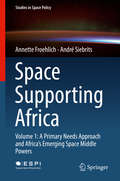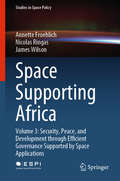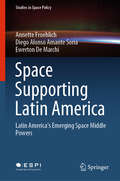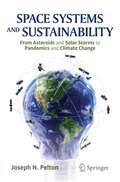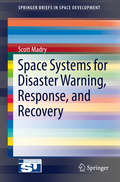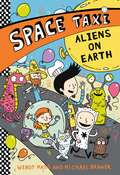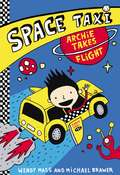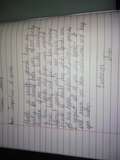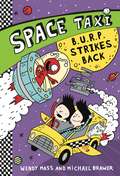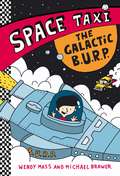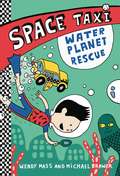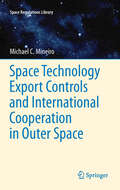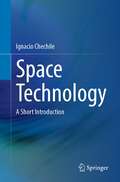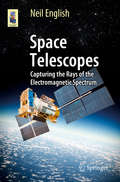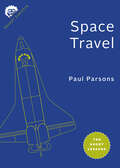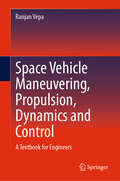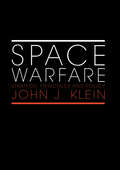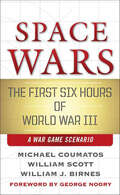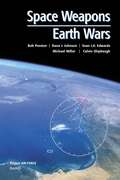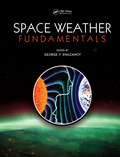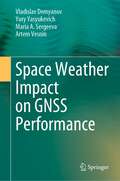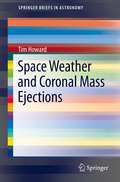- Table View
- List View
Space Studies Board: Annual Report 2014
by National Research Council of the National AcademiesUnder the leadership of Jonathan Lunine and Mitch Daniels, the Committee on Human Spaceflight completed one of the most challenging studies undertaken by the Space Studies Board and the Aeronautics and Space Engineering Board. In Pathways to Exploration: Rationales and Approaches for a U.S. Program of Human Exploration, a diverse committee of experts tackled not only the question, How should humans explore space?, but the even more challenging question, Why should humans explore space? <P> The committee identified a pair of enduring questions that motivate human spaceflight: How far from Earth can humans go? and What can humans discover and achieve when we get there? The committee then explored a range of rationales for human spaceflight ranging from the pragmatic (its economic, national security, scientific exploration, international relations, and technology impacts) to the aspirational—the notion that space is humanity’s future. While the committee did not identify a single rationale as the primary justification for space exploration and could not quantify the economic benefit of space exploration, it did conclude that a mix of rationales motivates space exploration. <P><P> Along with an examination of public and stakeholder attitudes about human exploration, the report evaluated three different pathways to illustrate the trade-offs among affordability, schedule, developmental risk, and the frequency of missions for different sequences of intermediate destinations. The pathways, all of which culminate in landing on the surface of Mars, include some combination of missions to asteroids, the Moon, and martian moons.
Space Supporting Africa: Volume 1: A Primary Needs Approach and Africa’s Emerging Space Middle Powers (Studies in Space Policy #20)
by Annette Froehlich André SiebritsIn this book the background and context of Africa’s political and socio-economic landscape is presented and unpacked through a primary needs approach which focuses on climate, biodiversity, health, water, education, and space-related capacity building. African theoretical contributions from the International Relations field are discussed, and Africa’s new Space Policy and Strategy, along with debates around the establishment of an African Space Agency, are explored. The African International Space Ecosystem is then analyzed, including its dimensions of intra-African space relations and initiatives, African participation in COPUOS, and international space activities, agreements, and initiatives in Africa. The final part is dedicated to the national space infrastructure and activities of African states.
Space Supporting Africa: Volume 3: Security, Peace, and Development through Efficient Governance Supported by Space Applications (Studies in Space Policy #28)
by James Wilson Annette Froehlich Nicolas RingasAfrica faces numerous challenges relating to good governance due to its vast and diverse landscape, as well as its history. This book explores the role of space-based applications in supporting African good governance by strengthening civil society, bolstering democratic processes and advancing socio-economic development. The increased use of such applications can accelerate Africa's progress towards the United Nations Agenda 2030 Sustainable Development Goals, as well as the African Union's Agenda 2063 aspirations This book examines key challenges facing governance within African to provide an accurate account of the current African context. It discusses specific examples of e-governance and digital solutions that leverage space-based technologies and have been successfully implemented in both the developed and developing world. In the context of the numerous satellite constellations being deployed to provide affordable Internet connectivity globally, it examines the major actors in this sector and presents additional governance solutions based on remote sensing and Earth observation data. Given its scope, the book will be of interest to professionals and students in the fields of development, governance and space studies.
Space Supporting Latin America: Latin America's Emerging Space Middle Powers (Studies in Space Policy #25)
by Annette Froehlich Diego Alonso Amante Soria Ewerton De MarchiThis book examines the background and context of Latin America's political and socioeconomic landscape with a focus on space activities. Firstly, it discusses Latin America's contribution to this sector from an international relations perspective, and explores the debates around the establishment of a Latin American Space Agency. It then highlights space-related capacity building, Latin America’s participation in UNCOPUOS, and international space activities, agreements, and initiatives in Latin America. The second part is devoted to the national space infrastructures and space activities of Latin American states. It analyzes various spacefaring countries in the context of their intra-regional space relations and initiatives as well as their bi-lateral cooperation programs. This timely book is of interest to scholars and professionals working in the space field, especially those in Latin America and other emerging countries.
Space Systems and Sustainability: From Asteroids and Solar Storms to Pandemics and Climate Change
by Joseph N. PeltonIn his latest book, space scientist, futurist, and educator Joseph N. Pelton explores adozen ways that Planet Earth is at “existential” risk, along with the many ways thatspace systems, data analytics, and advanced networking systems can help us copewith these global challenges.The chapters examine in a straightforward way how satellite systems and technol-ogy can drastically transform fields such as pandemic tracking and global medicalresponses, cosmic hazard monitoring, nuclear energy and waste disposal, water andland pollution, tele-education/telemedicine, and military conflict. Such examplesshow how orbiting smart systems will play an ever more vital role in our vulnerablemodern world, allowing us to monitor, track, and respond to mounting problems ofthe 21st century.Dr. Pelton takes a broad view, probing the social, economic, and regulatory factorsthat are crucial to creating a more sustainable “Spaceship Earth.” This book is a callto action, promoting more organized international collaboration and investment in space technologies that can enable global change.
Space Systems for Disaster Warning, Response, and Recovery
by Scott MadryThis SpringerBrief provides a general overview of the role of satellite applications for disaster mitigation, warning, planning, recovery and response. It covers both the overall role and perspective of the emergency management community as well as the various space applications that support their work. Key insights are provided as to how satellite telecommunications, remote sensing, navigation systems, GIS, and the emerging domain of social media are utilized in the context of emergency management needs and requirements. These systems are now critical in addressing major man-made and natural disasters. International policy and treaties are covered along with various case studies from around the world. These case studies indicate vital lessons that have been learned about how to use space systems more effectively in addressing the so-called "Disaster Cycle. " This book is appropriate for practicing emergency managers, Emergency Management (EM) courses, as well as for those involved in various space applications and developing new satellite technologies.
Space Taxi: Aliens on Earth (Space Taxi #6)
by Wendy Mass Michael BrawerArchie Morningstar fights crime across the universe alongside his dad and Pockets the talking cat. In his sixth adventure, the space taxi navigation system goes down, stranding all the alien passengers on Earth! Will the team be able to find hiding spots for these otherworldly creatures before they're discovered, or will this be the end of the operation for good? Get ready for another exciting intergalactic adventure.
Space Taxi: Archie Takes Flight (Space Taxi #1)
by Wendy Mass Michael Brawer Elise GravelArchie Morningstar learns a big family secret and helps save the universe. All before breakfast!It's not every day a regular kid like Archie gets to wake up at midnight. But today is Take Your Kid to Work Day, and Archie is finally allowed to ride along in his dad's taxi cab. He has been waiting eight years, eight months, and eight days for this moment to arrive.But he's about to discover his dad is no ordinary cab driver...In fact, he drives an intergalactic space taxi! All night long, he shuttles aliens from one corner of the universe to another. And being a space taxi copilot is no easy task: Archie must steer them into wormholes, keep them from crashing into planets, deal with a very unusual cat...and save the universe from an evil mastermind!Space Taxi marks the debut of a brand new chapter book series from New York Times bestselling author Wendy Mass and teacher Michael Brawer, filled with humor, adventure, and plenty of science to impress your friends and teachers!
Space Taxi: Archie's Alien Disguise (Space Taxi #3)
by Wendy Mass Michael BrawerArchie Morningstar's dad drives a taxi through outer space! And with the help of a talking cat named Pockets, Archie and his dad help fight crime across the universe.In the third book in the series, Archie, his dad, and Pockets visit a planet that resembles medieval Earth in every way but its inhabitants, who have rainbow colored hair and extra eyes. To beat the evil organization B.U.R.P., the trio must disguise themselves as aliens and rescue a princess! When Archie must act on his own, can he find the courage to save the day?
Space Taxi: B.U.R.P. Strikes Back (Space Taxi #5)
by Wendy Mass Michael BrawerBook five in the intergalactic science-based chapter book series from New York Times bestselling author Wendy Mass and Michael Brawer! Archie Morningstar fights crime across the universe alongside his dad and Pockets the talking cat. In Archie's fifth adventure, Pockets is in a panic: all the tuna fish sandwiches on Akbar's Floating Rest Stop have been stolen! He thinks it's the fault of the irritating head of his alien fan club, but Archie suspects the mystery goes much deeper. Get ready for another thrilling and hilarious space adventure!
Space Taxi: The Galactic B.U.R.P. (Space Taxi #4)
by Wendy Mass Michael BrawerArchie Morningstar's dad drives a taxi through outer space! And with the help of a talking cat named Pockets, Archie and his dad help fight crime across the universe.In this fourth book in the series, Archie is taken to the criminal organization B.U.R.P.'s mothership where he must outsmart evil masterminds!
Space Taxi: Water Planet Rescue (Space Taxi #2)
by Wendy Mass Michael BrawerArchie Morningstar's dad drives a taxi through outer space! And with the help of a talking cat named Pockets, Archie and his dad help fight crime across the universe.In the second book in this series, Archie, his dad, and Pockets fly to a planet in peril: someone is stealing the water from this underwater world! Can Archie and Pockets save the day?
Space Technology Export Controls and International Cooperation in Outer Space
by Michael MineiroExport controls definitively impact international cooperation in outer space. Civil and commercial space actors that engage in international endeavors must comply with space technology export controls. In the general discourse, members of the civil and commercial space community have an understanding of their domestic export control regime. However, a careful reading of the literature on space technology export controls reveals that certain questions relevant to international engagements have not been identified or answered. What is the legal-political origin of space technology export controls? How do they relate to the current international legal structure? What steps can be taken to evolve our current unilateral paradigm of space technology within the context of peaceful exploration and use of outer space? In this book, these and other relevant questions on space technology export controls are identified and assessed through an insightful case-study of the U.S. commercial communication export control regime. The findings of this case-study are used in an international legal-political analysis of international space law, public international law, and international cooperation. Breaking new ground in international legal theory, a self-justified security dilemma that is manifest in international law is identified and explained as the origin for the current paradigm of space technology export controls.
Space Technology: A Short Introduction
by Ignacio ChechileThis engaging and accessible book is designed as a quick and easy way to get up to speed on all things in space technology. It also offers extensive references and links that allow readers to delve deeper into the subject.Whether you were a newcomer to space technology or a seasoned professional, this book is the best way to brush up on the basics of everything from satellite design and construction to the physics behind objects orbiting celestial bodies.Written in an accessible tone that is easy to understand, this book is perfect for reading during a short flight or any other spare moment you might have. You can learn about the main laws of Physics behind objects in orbit, the environments that satellites face while in space, and the processes involved in designing and building these incredible machines. Along the way, you can also get a glimpse into the history of space technology, including the foundational technologies that have made it all possible. So why not join the community of space enthusiasts and get up to speed on everything you need to know about space technology?
Space Telescopes
by Neil EnglishSpace telescopes are among humankind's greatest scientific achievements of the last fifty years. This book describes the instruments themselves and what they were designed to discover about the Solar System and distant stars. Exactly how these telescopes were built and launched and the data they provided analyzed is explored. Only certain kinds of radiation can penetrate our planet's atmosphere, which limits what we can observe. But with space telescopes all this changed. We now have the means to "see" ultraviolet, microwave, and infrared rays, X-rays and gamma rays beyond Earth. In this book we meet the pioneers and the telescopes that were built around their ideas. This book looks at space telescopes not simply chronologically but also in order of the electromagnetic spectrum. This makes it possible to understand better why they were made, and just what it was that justified the huge investments in the technology.
Space Terahertz Remote Sensing Technology (Space Science, Technology and Application Series)
by Weidong Hu Yuming Bai Xin LvThis book examines terahertz technology and its applications in atmospheric remote sensing.Terahertz waves are electromagnetic radiation between microwaves and infrared radiation in the electromagnetic spectrum. They have the capability of greater directivity, higher power density, higher resolution imaging, richer fingerprint spectrum, wider bandwidth and faster transmission rate. Such properties promise great potential for terahertz technology applications in many fields, particularly in the detection of substances and the exploration of space. The book begins with an introduction to the development of space terahertz remote sensing and the underlying theories. The next seven chapters cover the key equipment and critical technologies for terahertz remote sensing, including the terahertz radiometer and its calibration and receiver link; the terahertz reflector antenna and its tolerance analysis; remote sensing imagery; and space resolution enhancement of both oversampled and non-oversampled data. The final chapter presents the application of terahertz imaging technology in the field of security inspection.This title will serve as a valuable reference for academics, students and engineers in the fields of terahertz technology, space science and remote sensing. Professionals in atmospheric remote sensing and inspection imaging will also benefit from this book.
Space Travel: Ten Short Lessons (Pocket Einstein Series)
by Paul ParsonsAn expert yet easy-to-understand examination of space travel, from the first human voyages to the goals of future endeavors.In Space Travel: Ten Short Lessons, Paul Parsons takes us on an exhilarating journey to examine the game-changing discoveries in the history of space exploration that have illuminated the darkest corners of our universe.From the amazing technology that has enabled us to look beyond the clouds to the development of rockets and spacecraft during the twentieth century that led to missions to the moon and beyond, to the space tourism of the twenty-first century, this is a cutting-edge, expert-led guide for curious minds.About the series: The Pocket Einstein series is a collection of essential pocket-sized guides for anyone looking to understand a little more about some of the most relevant science that affects us all in the twenty-first century. Broken down into ten simple lessons and written by leading experts in their field, the books reveal the ten most important takeaways from those areas of science we should all know more about.
Space Vehicle Maneuvering, Propulsion, Dynamics and Control: A Textbook for Engineers
by Ranjan VepaThis textbook introduces space vehicle maneuvering, propulsion, dynamics and control, and discusses the space environment and its influence on the spacecraft propulsion system. This is followed by an in depth description of Keplerian celestial mechanics, co-planar and non-planar orbital transfers involving both impulsive and continuous manoeuvers, and perturbation effects that characterize the real non-Keplerian nature of orbital motion. Dr. Vepa then explains the use of restricted two-body and three-body dynamics as descriptors of spacecraft motion, the limitations of these approach in terms of orbital perturbations and an understanding of the physical source and influence of these perturbations, and principles of the optimal synthesis of trajectories. Featuring many exercises, design case studies, and extensive use of MATLAB/SIMULINK and MATLAB analytical tools, the book is ideal for graduate students, post graduate students, researchers, as well professionals in the industry.
Space Warfare: Strategy, Principles and Policy (Space Power and Politics)
by John J. KleinThis new study considers military space strategy within the context of the land and naval strategies of the past. Explaining why and how strategists note the similarities of space operations to those of the air and naval forces, this book shows why many such strategies unintentionally lead to overemphasizing the importance of space-based offensive weaponry and technology. Counter to most U.S. Air Force doctrines, the book argues that space-based weapons don’t imbue superiority. It examines why both air and naval strategic frameworks actually fail to adequately capture the scope of real-world issues regarding current space operations. Yet by expanding a naval strategic framework to include maritime activities—which includes the interaction of land and sea—the breadth of issues and concerns regarding space activities and operations can be fully encompassed. Commander John Klein, United States Navy, uses Sir Julian Corbett’s maritime strategy as a strategic springboard, while observing the salient lessons of other strategists—including Sun Tzu, Clausewitz, Jomini, and Mao Tse-tung—to show how a space strategy and associated principles of space warfare can be derived to predict concerns, develop ideas, and suggest policy not currently recognized. This book will be of great interest to all students and scholars of military and strategic studies and to those with an interest in space strategy in particular.
Space Wars: The First Six Hours of World War III, a War Game Scenario
by William J. Birnes William Scott Michael CoumatosMichael J. Coumatos is a former U.S. Navy test pilot, ship's captain, and commodore; U.S. Space Command director of wargaming; and a government counterterrorism advisor. William Scott is a retired bureau chief of Aviation Week and Space Technology and a nine-year Air force veteran who served as aircrew on nuclear sampling missions. He is a six-time Royal Aeronautical Society "Journalist of the Year" finalist, and won the Society's 1998 Lockheed Martin Award for the "Best Defense Submission." He also received both the 2006 and 2007 Messier-Dowty awards for "Best Airshow Submission." With the help of New York Times bestselling author William J. Birnes, these renowned experts have joined forces to grippingly depict how the first hours of World War III might play out in the year 2010.Coumatos, Scott, and Birnes take the reader inside U.S. Strategic Command, where top military commanders, space-company executives, and U.S. intelligence experts are conducting a DEADSATS II wargame, exploring how the loss of critical satellites could lead to nuclear war. The players don't know that the war they are gaming has already begun, miles above them in the lifeless, silent cold of space. Jam-packed with the actual systems and secret technologies the United States has or will soon field to protect its space assets, Space Wars describes a near-future nuclear nightmare that terrorists will relish but politicians prefer to ignore. In a quieter, more peaceful time, Space Wars would be an exciting work of fiction. But with the United States now at war, Space Wars is all too real. .At the Publisher's request, this title is being sold without Digital Rights Management Software (DRM) applied.
Space Weapons Earth Wars
by Dana J. Johnson Michael D. Miller Robert Preston Sean J. Edwards Calvin ShipbaughThis overview aims to inform the public discussion of space-based weapons by examining their characteristics, potential attributes, limitations, legality, and utility. The authors do not argue for or against space weapons, nor do they estimate the potential costs and performance of specific programs, but instead sort through the realities and myths surrounding space weapons in order to ensure that debates and discussions are based on fact.
Space Weather Fundamentals
by George V. KhazanovSpace weather is one of the most significant natural hazards to human life and health. Conditions of the sun and in the solar wind, magnetosphere, ionosphere, and thermosphere can influence the performance and reliability of space-borne and ground-based technological systems. If conditions in the space environment are adverse, they can cause disruption of satellite operations, communications, navigation, and electric power distribution grids, leading to a variety of socioeconomic losses. This book provides an overview of our current knowledge and theoretical understanding of space weather formation and covers all major topics of this phenomena, from the sun to the Earth’s ionosphere and thermosphere, thus providing a fully updated review of this rapidly advancing field. The book brings together an outstanding team of internationally recognised contributors to cover topics such as solar wind, the earth's magnetic field, radiation belts, the aurora, spacecraft charging, orbital drag and GPS.
Space Weather Impact on GNSS Performance
by Vladislav Demyanov Yury Yasyukevich Maria A. Sergeeva Artem VesninThis book addresses problems of GNSS performance support under geomagnetic storms and solar radio bursts. It analyses both physical and radio-engineering sources of GNSS performance deterioration caused by geomagnetic storms, solar radio bursts and peculiarities of the polar and equatorial ionosphere. The book takes into consideration both standalone GNSS and differential GNSS. Based on experimental data analysis, it presents a systematic approach to maintaining reliable GNSS performance despite the Space Weather impacts.Given its scope, the book offers a valuable resource for GNSS users and equipment developers, as well as researchers and students whose work involves GNSS remote sensing, surveying, navigation, and related disciplines.
Space Weather and Coronal Mass Ejections
by Tim HowardSpace weather has attracted a lot of attention in recent times. Severe space weather can disrupt spacecraft, and on Earth can be the cause of power outages and power station failure. It also presents a radiation hazard for airline passengers and astronauts. These "magnetic storms" are most commonly caused by coronal mass ejections, or CMES, which are large eruptions of plasma and magnetic field from the Sun that can reach speeds of several thousand km/s. In this SpringerBrief, Space Weather and Coronal Mass Ejections, author Timothy Howard briefly introduces the coronal mass ejection, its scientific importance, and its relevance to space weather at Earth and other planets. This title focuses on the latest advances in CME observation and modeling, including new results from the NASA STEREO and SDO missions. It also includes topical issues regarding space weather and the most recent observations and anecdotal examples of the impacts of space weather and CMEs.
Space and Astrophysical Plasma Simulation: Methods, Algorithms, and Applications
by Jörg BüchnerThis book is a collection of contributions covering the major subjects in numerical simulation of space and astrophysical plasma. It introduces the different approaches and methods to model plasma, the necessary computational codes, and applications in the field. The book is rooted in the previous work Space Plasma Simulation (Springer, 2003) and includes the latest developments. It is divided into three parts and all chapters start with an introduction motivating the topic and its use in research and ends with a discussion of its applications. The chapters of the first part contain tutorials of the different basic approaches needed to perform space plasma simulations. This part is particularly useful for graduate students to master the subject. The second part presents more advanced materials for students and researchers who already work with pre-existing codes but want to implement the recent progresses made in the field. The last part of the book discusses developments in the area for researchers who are actively working on advanced simulation approaches like higher order schemes and artificial intelligence, agent-based technologies for multiscale and multi-dimensional systems, which represent the recent innovative contributions made in space plasma research.

